Stone and Sand & Gravel Industry Sector
On This Page
Introduction
The following maps, graphs, and tables present data for the Stone and Sand & Gravel Industry Sector. The information is organized by Mines, Employees, Fatalities, and Injuries. The Mines section contains information on the locations and number of the active mining operations. The Employees section details the number of mine operator employees by county and the number of employee hours by work location. The Fatalities section describes the number of mine operator and contractor fatalities overall and by work location. The Injuries section presents the number of nonfatal lost-time injuries by county, the number by work location, and the number of injuries by accident class. Note: Sand & Gravel mining occurs at surface locations only. Data source: Mine Safety and Health Administration (MSHA). See Statistical Methodology for further details. Additional Mining Facts for each commodity are available from 2000 through 2015.
Mines
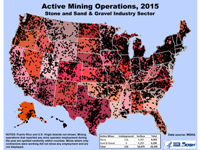 Active Mining Operations, 2015 (Stone and Sand & Gravel Industry Sector): Map of the United States displaying the locations of active mining operations spotted randomly within counties for the stone and sand & gravel industry sector in 2015. Active mines are mining operations that reported mine operator employment during the year. Of the 10,595 stone and sand & gravel mines, 4,303 were stone and 6,292 were sand & gravel. Mines at which only contractors were working did not show any employment and are not displayed.
Active Mining Operations, 2015 (Stone and Sand & Gravel Industry Sector): Map of the United States displaying the locations of active mining operations spotted randomly within counties for the stone and sand & gravel industry sector in 2015. Active mines are mining operations that reported mine operator employment during the year. Of the 10,595 stone and sand & gravel mines, 4,303 were stone and 6,292 were sand & gravel. Mines at which only contractors were working did not show any employment and are not displayed.
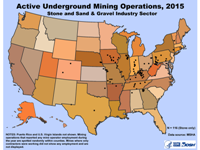 Active Underground Mining Operations, 2015 (Stone and Sand & Gravel Industry Sector): Map of the United States displaying the locations of active underground mining operations spotted randomly within counties for the stone and sand & gravel industry sector in 2015. Active mines are mining operations that reported mine operator employment during the year. There were 116 underground stone mines and no underground sand & gravel mining operations. Mines at which only contractors were working did not show any employment and are not displayed.
Active Underground Mining Operations, 2015 (Stone and Sand & Gravel Industry Sector): Map of the United States displaying the locations of active underground mining operations spotted randomly within counties for the stone and sand & gravel industry sector in 2015. Active mines are mining operations that reported mine operator employment during the year. There were 116 underground stone mines and no underground sand & gravel mining operations. Mines at which only contractors were working did not show any employment and are not displayed.
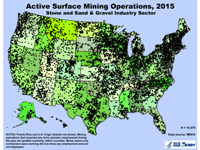 Active Surface Mining Operations, 2015 (Stone and Sand & Gravel Industry Sector): Map of the United States displaying the locations of active surface mining operations spotted randomly within counties for the stone and sand & gravel industry sector in 2015. Active mines are mining operations that reported mine operator employment during the year. There were 10,479 surface stone and sand & gravel mining operations. Mines at which only contractors were working did not show any employment and are not displayed.
Active Surface Mining Operations, 2015 (Stone and Sand & Gravel Industry Sector): Map of the United States displaying the locations of active surface mining operations spotted randomly within counties for the stone and sand & gravel industry sector in 2015. Active mines are mining operations that reported mine operator employment during the year. There were 10,479 surface stone and sand & gravel mining operations. Mines at which only contractors were working did not show any employment and are not displayed.
Employees
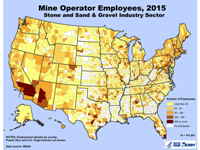 Mine Operator Employees, 2015 (Stone and Sand & Gravel Industry Sector): Map of the United States displaying employment density by county for the 101,851 mine operator employees in the stone and sand & gravel industry sector during 2015. A graduated color ramp is used to symbolize densities of less than 25 employees, 25 to 49 employees, 50 to 199 employees, 200 to 499 employees, and 500 or more employees.
Mine Operator Employees, 2015 (Stone and Sand & Gravel Industry Sector): Map of the United States displaying employment density by county for the 101,851 mine operator employees in the stone and sand & gravel industry sector during 2015. A graduated color ramp is used to symbolize densities of less than 25 employees, 25 to 49 employees, 50 to 199 employees, 200 to 499 employees, and 500 or more employees.
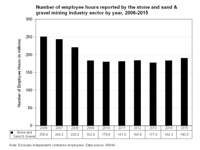 Number of Employee Hours Reported by the Stone and Sand & Gravel Mining Industry Sector by Year, 2006-2015: Graph displaying the number of mine operator employee hours reported by the stone and sand & gravel mining industry sector from 2006 through 2015. The employee hours declined over the period from 250.4 million hours in 2006 to 190.0 million hours in 2015.
Number of Employee Hours Reported by the Stone and Sand & Gravel Mining Industry Sector by Year, 2006-2015: Graph displaying the number of mine operator employee hours reported by the stone and sand & gravel mining industry sector from 2006 through 2015. The employee hours declined over the period from 250.4 million hours in 2006 to 190.0 million hours in 2015.
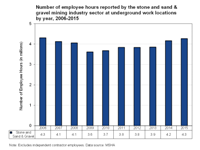 Number of Employee Hours Reported by the Stone and Sand & Gravel Mining Industry Sector at Underground Work Locations by Year, 2006-2015: Graph displaying the number of underground mine operator employee hours reported by the stone and sand & gravel mining industry sector from 2006 through 2015. The employee hours varied over the period ranging from 3.6 million to 4.3 million hours, with 4.3 million hours being reported for 2015.
Number of Employee Hours Reported by the Stone and Sand & Gravel Mining Industry Sector at Underground Work Locations by Year, 2006-2015: Graph displaying the number of underground mine operator employee hours reported by the stone and sand & gravel mining industry sector from 2006 through 2015. The employee hours varied over the period ranging from 3.6 million to 4.3 million hours, with 4.3 million hours being reported for 2015.
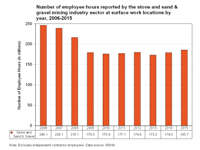 Number of Employee Hours Reported by the Stone and Sand & Gravel Mining Industry Sector at Surface Work Locations by Year, 2006-2015: Graph displaying the number of surface mine operator employee hours reported by the stone and sand & gravel mining industry sector from 2006 through 2015. The employee hours declined over the period from 246.1 million hours in 2006 to 179.3 million hours in 2009. From there, the numbers remained stable with 173.2 million hours reported for 2013. The hours increased to 185.7 million in 2015.
Number of Employee Hours Reported by the Stone and Sand & Gravel Mining Industry Sector at Surface Work Locations by Year, 2006-2015: Graph displaying the number of surface mine operator employee hours reported by the stone and sand & gravel mining industry sector from 2006 through 2015. The employee hours declined over the period from 246.1 million hours in 2006 to 179.3 million hours in 2009. From there, the numbers remained stable with 173.2 million hours reported for 2013. The hours increased to 185.7 million in 2015.
Fatalities
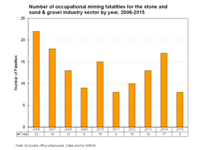 Number of Occupational Mining Fatalities for the Stone and Sand & Gravel Industry Sector by Year, 2006-2015: Graph displaying the number of occupational mining fatalities, excluding office employees, from 2006 through 2015 for the stone and sand & gravel industry sector. The numbers vary by year with the highest number occurring in 2006 when 22 were fatalities reported. The lowest number reported during the period was 8 fatalities in 2011 and 2015.
Number of Occupational Mining Fatalities for the Stone and Sand & Gravel Industry Sector by Year, 2006-2015: Graph displaying the number of occupational mining fatalities, excluding office employees, from 2006 through 2015 for the stone and sand & gravel industry sector. The numbers vary by year with the highest number occurring in 2006 when 22 were fatalities reported. The lowest number reported during the period was 8 fatalities in 2011 and 2015.
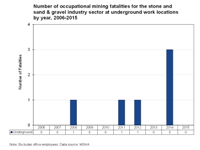 Number of Occupational Mining Fatalities for the Stone and Sand & Gravel Industry Sector at Underground Work Locations by Year, 2006-2015: Graph displaying the number of occupational mining fatalities, excluding office employees, occurring at underground work locations from 2006 through 2015 for the stone and sand & gravel industry sector. Over the period, a total of 6 fatalities were reported with a high of 3 occurring in 2014. No underground fatalities occurred in 2006, 2007, 2009, 2010, 2013, or 2015.
Number of Occupational Mining Fatalities for the Stone and Sand & Gravel Industry Sector at Underground Work Locations by Year, 2006-2015: Graph displaying the number of occupational mining fatalities, excluding office employees, occurring at underground work locations from 2006 through 2015 for the stone and sand & gravel industry sector. Over the period, a total of 6 fatalities were reported with a high of 3 occurring in 2014. No underground fatalities occurred in 2006, 2007, 2009, 2010, 2013, or 2015.
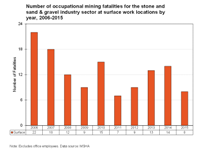 Number of Occupational Mining Fatalities for the Stone and Sand & Gravel Industry Sector at Surface Work Locations by Year, 2006-2015: Graph displaying the number of occupational mining fatalities, excluding office employees, occurring at underground work locations from 2006 through 2015 for the stone and sand & gravel industry sector. The numbers vary by year from a high of 22 fatalities in 2006, to a low of 7 fatalities in 2011. There were 8 fatalities at surface work locations in 2015.
Number of Occupational Mining Fatalities for the Stone and Sand & Gravel Industry Sector at Surface Work Locations by Year, 2006-2015: Graph displaying the number of occupational mining fatalities, excluding office employees, occurring at underground work locations from 2006 through 2015 for the stone and sand & gravel industry sector. The numbers vary by year from a high of 22 fatalities in 2006, to a low of 7 fatalities in 2011. There were 8 fatalities at surface work locations in 2015.
Injuries
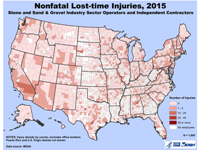 Nonfatal Lost-time Injuries, 2015 (Stone and Sand & Gravel Industry Sector Operators and Contractors): Map of the United States displaying nonfatal lost-time injury density by county for 1,600 Stone and Sand & Gravel Industry Sector operator and contractor injuries during 2015. Office workers are excluded. A graduated color ramp is used to symbolize densities of zero injuries, 1 to 9, 10 to 29, 30 to 49, and 50 or more injuries.
Nonfatal Lost-time Injuries, 2015 (Stone and Sand & Gravel Industry Sector Operators and Contractors): Map of the United States displaying nonfatal lost-time injury density by county for 1,600 Stone and Sand & Gravel Industry Sector operator and contractor injuries during 2015. Office workers are excluded. A graduated color ramp is used to symbolize densities of zero injuries, 1 to 9, 10 to 29, 30 to 49, and 50 or more injuries.
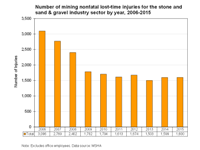 Number of Mining Nonfatal Lost-time Injuries for the Stone and Sand & Gravel Industry Sector by Year, 2006-2015: Graph displaying the number of mining nonfatal lost-time injuries for the stone and sand & gravel industry sector, excluding office employees, from 2006 through 2015. The number of injuries has declined by almost half over the period from a high of 3,096 in 2006 to a low of 1,503 in 2013. The nonfatal lost-time injuries increased to 1,600 in 2015.
Number of Mining Nonfatal Lost-time Injuries for the Stone and Sand & Gravel Industry Sector by Year, 2006-2015: Graph displaying the number of mining nonfatal lost-time injuries for the stone and sand & gravel industry sector, excluding office employees, from 2006 through 2015. The number of injuries has declined by almost half over the period from a high of 3,096 in 2006 to a low of 1,503 in 2013. The nonfatal lost-time injuries increased to 1,600 in 2015.
Number of Mining Nonfatal Lost-time Injuries for the Stone and Sand & Gravel Industry Sector at Underground Work Locations by Year, 2006-2015: Graph displaying the number of mining nonfatal lost-time injuries for the stone and sand & gravel industry sector, excluding office employees, from 2006 through 2015. The number of nonfatal lost-time injuries declined over the period from 43 in 2006 to 33 in 2008. Then, the numbers varied between 36 and 45 injuries per year from 2009 to 2015. In 2015, there were 46 nonfatal lost-time injuries were reported.
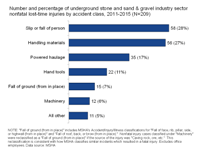 Number and Percentage of Underground Stone and Sand & Gravel Industry Sector Nonfatal Lost-time Injuries by Accident Class, 2011-2015: Graph displaying the distribution of nonfatal lost-time injuries by accident class for the stone and sand & gravel industry sector at underground mining locations for the period from 2011 through 2015. Excluding office employees, there were a total of 209 lost-time injuries. Slip or fall of person had 28.0%, "Handling materials" had 27.0%, and "Powered haulage" had 17.0% of the nonfatal lost-time injures. "Hand tools" accounted for 11.0% of the injuries. "Fall of ground (from in place)", which includes MSHA’s Accident/Injury/Illness Classifications for "Fall of face, rib, pillar, side, or highwall from in place" and "Fall of roof, back, or brow from in place," had 7.0% of the nonfatal lost-time injuries. Nonfatal injury cases classified under machinery were reclassified as a fall of ground (from in place) if the source of the injury was caving rock, ore, etc. This reclassification is consistent with how MSHA classifies similar incidents which resulted in a fatal injury. "Machinery" had 6.0% and the "All other" category reported 5.0% of the nonfatal lost-time injuries during the 5-year period. Note that the sum of percentages may not equal 100 due to independent rounding.
Number and Percentage of Underground Stone and Sand & Gravel Industry Sector Nonfatal Lost-time Injuries by Accident Class, 2011-2015: Graph displaying the distribution of nonfatal lost-time injuries by accident class for the stone and sand & gravel industry sector at underground mining locations for the period from 2011 through 2015. Excluding office employees, there were a total of 209 lost-time injuries. Slip or fall of person had 28.0%, "Handling materials" had 27.0%, and "Powered haulage" had 17.0% of the nonfatal lost-time injures. "Hand tools" accounted for 11.0% of the injuries. "Fall of ground (from in place)", which includes MSHA’s Accident/Injury/Illness Classifications for "Fall of face, rib, pillar, side, or highwall from in place" and "Fall of roof, back, or brow from in place," had 7.0% of the nonfatal lost-time injuries. Nonfatal injury cases classified under machinery were reclassified as a fall of ground (from in place) if the source of the injury was caving rock, ore, etc. This reclassification is consistent with how MSHA classifies similar incidents which resulted in a fatal injury. "Machinery" had 6.0% and the "All other" category reported 5.0% of the nonfatal lost-time injuries during the 5-year period. Note that the sum of percentages may not equal 100 due to independent rounding.
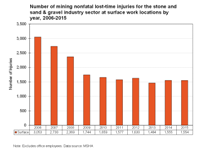 Number of Mining Nonfatal Lost-time Injuries for the Stone and Sand & Gravel Industry Sector at Surface Work Locations by Year, 2006-2015: Graph displaying the number of mining nonfatal lost-time injuries at surface work locations for the stone and sand & gravel industry sector, excluding office employees, from 2006 through 2015. The number of injuries declined over the period from a high of 3,053 in 2006 to a low of 1,464 in 2013. There were 1,554 nonfatal lost-time injuries reported in 2015.
Number of Mining Nonfatal Lost-time Injuries for the Stone and Sand & Gravel Industry Sector at Surface Work Locations by Year, 2006-2015: Graph displaying the number of mining nonfatal lost-time injuries at surface work locations for the stone and sand & gravel industry sector, excluding office employees, from 2006 through 2015. The number of injuries declined over the period from a high of 3,053 in 2006 to a low of 1,464 in 2013. There were 1,554 nonfatal lost-time injuries reported in 2015.
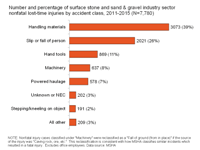 Number and Percentage of Surface Stone and Sand & Gravel Industry Sector Nonfatal Lost-time Injuries by Accident Class, 2011-2015: Graph displaying the distribution of nonfatal lost-time injuries by accident class for the stone and sand & gravel industry sector at surface mining locations from 2011 to 2015. Excluding office employees, there were a total of 7,780 lost-time injuries. "Handling materials" had 39.0%, "Slip or fall of person" had 26.0%, "Hand tools" had 11.0% and "Machinery" had 8.0% of the reported nonfatal lost-time injuries. Nonfatal injury cases classified under machinery were reclassified as a fall of ground (from in place) if the source of the injury was caving rock, ore, etc. This reclassification is consistent with how MSHA classifies similar incidents which resulted in a fatal injury. "Powered haulage" had 7.0%, “Unknown or NEC” had 3.0%, “Stepping/kneeling on object” had 2.0% and the "All other" category had 3.0%% of the nonfatal lost-time injuries during the 5-year period. Note that the sum of percentages may not equal 100 due to independent rounding.
Number and Percentage of Surface Stone and Sand & Gravel Industry Sector Nonfatal Lost-time Injuries by Accident Class, 2011-2015: Graph displaying the distribution of nonfatal lost-time injuries by accident class for the stone and sand & gravel industry sector at surface mining locations from 2011 to 2015. Excluding office employees, there were a total of 7,780 lost-time injuries. "Handling materials" had 39.0%, "Slip or fall of person" had 26.0%, "Hand tools" had 11.0% and "Machinery" had 8.0% of the reported nonfatal lost-time injuries. Nonfatal injury cases classified under machinery were reclassified as a fall of ground (from in place) if the source of the injury was caving rock, ore, etc. This reclassification is consistent with how MSHA classifies similar incidents which resulted in a fatal injury. "Powered haulage" had 7.0%, “Unknown or NEC” had 3.0%, “Stepping/kneeling on object” had 2.0% and the "All other" category had 3.0%% of the nonfatal lost-time injuries during the 5-year period. Note that the sum of percentages may not equal 100 due to independent rounding.
See Also
- Coal Industry Sector
- A Computer Software Program that Estimates Air Quantity Requirements in Large Opening Stone Mines
- The Effects of Water Emulsified Fuel on Diesel Particulate Matter Concentrations in Underground Mines
- Metal and Nonmetal Industry Sector
- Mining Fact Sheets
- Mining Facts - 2015
- Pillar Design Issues for Underground Stone Mines
- Preventing Injuries Caused by Unrecognized Stone Mine Roof Beam Failures With a Pro-Active Roof Control Plan
- Programmable Electronic Mining Systems: Best Practice Recommendations (In Nine Parts): Part 3: 2.2 Software Safety
- Roof and Rib Hazard Assessment for Underground Stone Mines
- Roof Span Design for Underground Stone Mines
- Statistical Methodology
- Statistics: Sand & Gravel Operators
- Statistics: Stone Operators
- Technique to Assess Hazards in Underground Stone Mines: the Roof Fall Risk Index (RFRI)
- Page last reviewed: 5/22/2017
- Page last updated: 5/22/2017
- Content source: National Institute for Occupational Safety and Health, Mining Program


 ShareCompartir
ShareCompartir